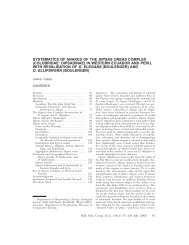cryptic species within the dendrophidion vinitor complex in middle ...
cryptic species within the dendrophidion vinitor complex in middle ...
cryptic species within the dendrophidion vinitor complex in middle ...
You also want an ePaper? Increase the reach of your titles
YUMPU automatically turns print PDFs into web optimized ePapers that Google loves.
SPECIES IN THE DENDROPHIDION VINITOR COMPLEX N Cadle 215<br />
and brown or black irregular spots. The first<br />
few bands on <strong>the</strong> neck and anterior body are<br />
broader than more posterior bands. Narrow<br />
broken blackish lateral stripe (or series of<br />
dashes/spots) occurs on <strong>the</strong> suture l<strong>in</strong>e<br />
between rows 2 and 3 on <strong>the</strong> posterior<br />
one-third of body. Black ventrolateral tail<br />
stripe on suture l<strong>in</strong>e between subcaudals<br />
and dorsocaudal row 1 extends to tail tip.<br />
Two specimens (LACM 148596, 148599)<br />
have more vivid band<strong>in</strong>g pattern than<br />
o<strong>the</strong>rs; <strong>the</strong>se two also tend to be grayer<br />
than o<strong>the</strong>rs, which are browner. Crossbands<br />
obscure <strong>in</strong> o<strong>the</strong>r preserved adults (LACM<br />
148590, 114106–07) seem<strong>in</strong>gly because <strong>the</strong>y<br />
are <strong>in</strong>vested with brown pigment (except for<br />
neck bands) nearly <strong>the</strong> same color as <strong>the</strong><br />
ground color and <strong>the</strong> crossband borders are<br />
not dist<strong>in</strong>ctly marked with pigment darker<br />
than ground color. Specimens with a dark<br />
brown ground color and contrast<strong>in</strong>g pale<br />
bands <strong>in</strong> life may have obscure bands when<br />
preserved (compare Figs. 15A and 16A).<br />
Top of head more or less uniform gray or<br />
brown down to superior edge of supralabials<br />
(last two supralabials mostly gray or brown).<br />
Fa<strong>in</strong>t blackish postocular stripe extends<br />
diagonally down across penultimate supralabial.<br />
Gular region immaculate.<br />
Lateral portions of ventrals with dense<br />
grayish black pigment, <strong>with<strong>in</strong></strong> which are<br />
darker irregular spots. Rema<strong>in</strong>der of most<br />
ventrals immaculate. However, posterior<br />
ventrals (up to about <strong>the</strong> 20th ventral<br />
anterior to <strong>the</strong> vent) have small scattered<br />
irregular black spots that vary <strong>in</strong> number<br />
from relatively many (LACM 148596,<br />
148599) to almost none (LACM 114106–<br />
07) (Fig. 14). Subcaudals with ventrolateral<br />
stripe (described above) and generally with<br />
dense blackish/gray pigment <strong>in</strong>vest<strong>in</strong>g subcaudals,<br />
especially along suture l<strong>in</strong>es, and<br />
scattered irregular small round black spots<br />
on many subcaudals (Fig. 14).<br />
Juveniles similar to adults but pale bands/<br />
ocelli are much better def<strong>in</strong>ed. Spott<strong>in</strong>g or<br />
stippl<strong>in</strong>g on posterior ventrals and proximal<br />
subcaudals very fa<strong>in</strong>t, but even relatively<br />
small specimens have f<strong>in</strong>e speckl<strong>in</strong>g of dark<br />
pigment on posterior portion of tail (e.g.,<br />
Figure 17. Distribution of Dendrophidion crybelum and of D.<br />
apharocybe <strong>in</strong> Costa Rica; see Savage (2002) for a more<br />
complete representation of localities. Arrows <strong>in</strong>dicate type<br />
localities. A few symbols represent multiple contiguous<br />
localities. Two localities <strong>in</strong>dicated by ‘‘3’’ <strong>with<strong>in</strong></strong> dots <strong>in</strong> western<br />
(Pacific) Costa Rica are erroneous localities for ‘‘D. <strong>v<strong>in</strong>itor</strong>’’<br />
<strong>in</strong>dicated by Savage (2002: 656); see <strong>species</strong> account for<br />
D. apharocybe.<br />
LACM 114108, 298 mm SVL), especially on<br />
suture l<strong>in</strong>es and laterally. Anterior ground<br />
color dark brown to blackish (contrast<strong>in</strong>g<br />
greatly with pale crossbands), becom<strong>in</strong>g<br />
lighter posteriorly (pale brown to tan on<br />
posterior half to two-thirds of body). Posterior<br />
lateral stripe broken; tail stripe quite<br />
dist<strong>in</strong>ct. Secondary pale bands between <strong>the</strong><br />
primary crossbands already evident <strong>in</strong><br />
LACM 148613–14. Width of pale dorsal<br />
bands <strong>in</strong> LACM 148614, 148617 is no more<br />
than about one scale wide. Juvenile Dendrophidion<br />
crybelum have a more contrast<strong>in</strong>g<br />
pattern and well-developed ocelli on <strong>the</strong><br />
posterior body compared with juvenile D.<br />
apharocybe.<br />
Distribution (Fig. 17). Def<strong>in</strong>itely known<br />
only from <strong>middle</strong> elevations (1,100–1,330 m)<br />
at <strong>the</strong> eastern end of <strong>the</strong> Fila Costeña and<br />
<strong>the</strong> south slope of <strong>the</strong> Cordillera Talamanca<br />
<strong>in</strong> southwestern Costa Rica. All known<br />
localities are <strong>in</strong> <strong>the</strong> uplands of <strong>the</strong> upper<br />
Río Coto Brus, separated from <strong>the</strong> lowlands<br />
of <strong>the</strong> Osa Pen<strong>in</strong>sula–Golfo Dulce by <strong>the</strong><br />
Fila Costeña. Despite relatively <strong>in</strong>tensive<br />
surveys, ‘‘D. <strong>v<strong>in</strong>itor</strong>’’ has not been recorded<br />
Bullet<strong>in</strong> of <strong>the</strong> Museum of Comparative Zoology harv-160-04-01.3d 11/4/12 19:59:39 215







